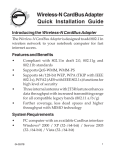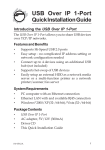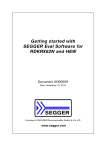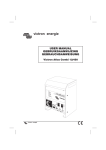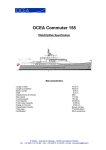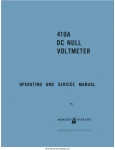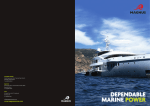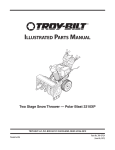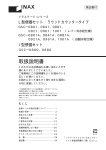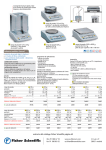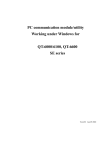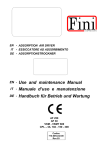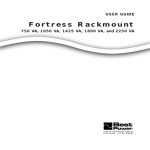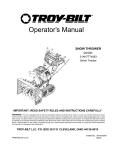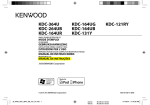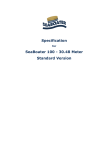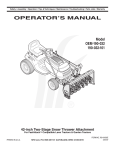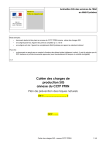Download Owner`s Manual Nautor`s SWAN 48 S CRUISER/RACER
Transcript
Nautor's SWAN 48 S C/R Owner’s Manual Nautor’s SWAN 48 S CRUISER/RACER VERSION Page 1 Nautor's SWAN 48 S C/R [THIS PAGE INTENSIONALY LEFT BLANK] Page 2 Nautor's SWAN 48 S C/R August 1996 Owner’s Manual Nautor’s SWAN 48S CRUISER/RACER VERSION This manual is intended to give some general maintenance hints and to serve as a guide to the proper use of equipment. INDEX 1. HULL 2. DECK 3. INTERIOR 4. ENGINE 5. PLUMBING 6. ELECTRICAL SYSTEMS 7. INSTRUMENTATION AND ELECTRONICS 8. RIG 9. HAULING 10. SPARE PARTS 11. DRAWINGS 12. TOOLS 13. APPENDICES Page 3 Nautor's SWAN 48 S C/R [THIS PAGE INTENSIONALY LEFT BLANK] Page 4 Nautor's SWAN 48 S C/R Section 1: HULL Page 5 Nautor's SWAN 48 S C/R [THIS PAGE INTENSIONALY LEFT BLANK] Page 6 Nautor's SWAN 48 S C/R 1 HULL INDEX 1.1 HULL 1.2 CLEANING 1.3 WAXING 1.4 SCRATCHES 1.5 PATCHING 1.6 UNDERWATER 1.7 ANTIFOULING 1.8 KEEL 1.9 STEERING SYSTEM 1.10 FLOATATION REFERENCE MARKS Page 7 Nautor's SWAN 48 S C/R [THIS PAGE INTENSIONALY LEFT BLANK] Page 8 Nautor's SWAN 48 S C/R 1.1 HULL The hull is of single skin construction with a hand laid glass/aramid hybrid fiber reinforced polyester resin laminate. A high proportion of the fibers are unidirectional. Stiffener flanges are reinforced with unidirectional glass. Inside surfaces of the hull have been finished in polyester topcoat. Standard color is Norpol GS 8008 grey. The topsides are finished in Norpol gelcoat. Standard color is NGN 2000 white, for boot top and cove stripe NGN 7005 blue. For possible repairs of the hull only compatible materials should be used. The gelcoat surfaces are not completely maintenance-free. The surface collects dirt and will slowly lose its gloss. Regular cleaning and waxing is needed to keep the surfaces in top condition. 1.2 CLEANING Soap and water or a detergent will remove most of the dirt. Gasoline or kerosene will remove oil and tar. If they fail, rubbing compound can be tried. Harsh abrasive and chemical cleaners are not recommended. Wet and dry sandpaper, 600 grit, is the strongest remedy, and must be followed by polishing with rubbing compound to restore the gloss. Be careful not to sand through the gelcoat surface. 1.3 WAXING Wax your boat at least once every year. Wax seals and protects the surface, minimizing the collection of dirt. Use special boat wax, or a silicone-free automotive type. Do not wax surfaces painted with polyurethane or epoxy. Wax will build up, collect dirt and then turn yellow. Painted surfaces need only regular washing with mild liquid soap. 1.4 SCRATCHES Shallow scratches are rather harmless, but if they are deep and expose the glassfibers, the laminate might absorb water by capillary action. This will impair the strength of the laminate, so instant action is needed. 1.5 PATCHING Pre-accelerated gelcoat for patching is delivered with the boat. The bigger can contains gelcoat for the hull, the smaller one is for the boot top. The bottle contains catalyst. Gelcoat can be stored about one year, or appreciably longer if kept in a cool place. The amount of catalyst to be added is 1.8%, which will give a working time of about 25 minutes at an ambient temperature of 20°C (68°F). For measuring catalyst, a graduated cylinder or disposable syringe is convenient. 1.8 ml per 100 g Page 9 Nautor's SWAN 48 S C/R gelcoat makes the right mixture, which equals about 12 drops per ounce. Before work can start, the damage area must be completely dry. Remove dirt and loose gelcoat, and de-wax around the edges with wax solvent. The use of acetone, chloroform, carbon tetrachloride, or methylenechloride is not recommended as they have a detrimental effect on the laminate if applied too liberally. Rub up the surface by sanding and put masking tape around the edges to limit the patch. Add catalyst to a suitable amount of gelcoat and spread the mixture over the damaged area, filling up a little overthickness, as the material shrinks when curing. To get a smooth surface, the repair work can be covered with cellophane and squeegeed down. After about twice the working time mentioned above has elapsed, the patch is cured and can be wet sanded smooth with 600-grit paper, followed by rubbing compound and wax. If your boat has been exposed to the sun a lengthy time, the patch at first may differ in color, but will fade in after a couple of months. 1.6 UNDERWATER To reduce the risk of osmosis or blistering, Nautor has applied two coats of epoxy tar over double unpigmented gelcoat layers to the GRP surfaces under the water line. It is extremely important that the surface is kept intact, as otherwise water might penetrate into the laminate, and possibly cause problems. Harsh grinding of the antifouling must therefore be avoided. If the epoxy or gelcoat layers have been damaged, they have to be restored as soon as possible. However, the risk of getting osmosis or blistering is small, as the bottom is well protected by the layers of epoxy tar and gelcoat. Six layers of epoxy is recommended where the gelcoat is missing. Renewal of the epoxy tar layer is recommended every five years. 1.7 ANTIFOULING Remember that antifouling contains toxic chemicals which can harm eyes and lungs. Never dry grind old antifouling as that will cause dust to fly around. Wear appropriate goggles and a respirator even when wet scrubbing or sanding. Never use paint removers on glassfiber surfaces, except the type specifically formulated for this substrate. Antifouling containing copper, lead or mercury may accelerate the deterioration of the propeller shaft zinc anode. The best way to remove antifouling is high-pressure water spray. 1.8 KEEL The keel is cast lead bolted to the bottom structure. Often, on hauling, it will be noticed that along the joint between the hull and the keel there is a crack in the filler. This is caused by different thermal expansion and contraction in the materials and should cause no problems. If the crack opens up when the boat is lifted, the keel bolts should be tightened. Recommended bolt torque: M24 260 Nm, M30 510 Nm. 1.9. STEERING SYSTEM Steering system drawing appended The rudder stock is made of E-glass composite, and supported by two roller bearings. These bearings should be greased regularly in order to turn easily. Page 10 Nautor's SWAN 48 S C/R The vertical position of the rudder can be adjusted at the upper end of the stock by adding or removing shims under the axial bearing surface. Steering cables should be hand tight. The adjusting screws are located at the quadrant. Check the cables regularly for wear. If there are any broken strands, change at the earliest opportunity. The steering wheel shaft has roller bearings which should be kept well greased. Winch grease or equivalent is recommended. The emergency tiller is stowed in the lazarette, and should always be kept easily available. Practice its installation, which could save vital time should it ever be required. 1.10 FLOATATION REFERENCE MARKS At bow and stern there are reference marks twelve inches (305 mm) above datum water line. With the aid of these the exact floatation can be determined. Note: Floatation is normally heavier than DWL - this is provided as a reference only. Page 11 Nautor's SWAN 48 S C/R [THIS PAGE INTENSIONALY LEFT BLANK] Page 12 Nautor's SWAN 48 S C/R Section 2: DECK Page 13 Nautor's SWAN 48 S C/R [THIS PAGE INTENSIONALY LEFT BLANK] Page 14 Nautor's SWAN 48 S C/R 2. DECK INDEX 2.1 DECK 2.2 LIFERAFT STOWAGE 2.3 WINCHES 2.4 BLOCKS AND SHEET CARS 2.5 WINDOWS AND HATCHES 2.6 ANCHOR WINDLASS 2.7 TEAKDECK Page 15 Nautor's SWAN 48 S C/R [THIS PAGE INTENSIONALY LEFT BLANK] Page 16 Nautor's SWAN 48 S C/R 2.1 DECK Deck arrangement appended. The deck is a PVC foam cored sandwich construction using the same materials as the hull, with hard core areas under fittings. The deck is finished in Norpol gelcoat. Standard color is NGN 2000 white, for the coaming stripe NGN 7005 blue. Maintenance directions for the deck are the same as for the hull, see Section 1. 2.2 LIFERAFT STOWAGE Check occasionally that the rafts are dry, as they otherwise may suffer. Do not stow other equipment so it prevents access to the rafts. 2.3 WINCHES Directions for use and servicing are given in Lewmar's System Service Manual. The winches and deck hardware are fastened through deck to aluminum back-up plates. After offshore trips rinse the winches with fresh water to remove salt deposits and reduce corrosion. Winches should be kept well lubricated. Check regularly that winch base drain holes are open. 2.4 BLOCKS AND SHEET CARS Maintenance instructions for Harken hardware is appended. Halyard arrangement The layout of the halyard exits on the mast requires that the halyards and lifts are arranged as shown on the deck arrangement drawing. 2.5 WINDOWS AND HATCHES The side windows and deck hatches are made of tinted acrylic. Wash the windows with mild liquid soap. Do not use solvents or abrasives. Page 17 Nautor's SWAN 48 S C/R [THIS PAGE INTENSIONALY LEFT BLANK] Page 18 Nautor's SWAN 48 S C/R Section 3: INTERIOR Page 19 Nautor's SWAN 48 S C/R [THIS PAGE INTENSIONALY LEFT BLANK] Page 20 Nautor's SWAN 48 S C/R 3. INTERIOR INDEX 3.1 GENERAL 3.2 FLOORBOARDS 3.3 OVERHEAD PANELS Page 21 Nautor's SWAN 48 S C/R [THIS PAGE INTENSIONALY LEFT BLANK] Page 22 Nautor's SWAN 48 S C/R 3.1 GENERAL Interior arrangement appended. Take care of the interior, keep the boat well ventilated at all times. All wood surfaces are varnished with several coats of SADOLUX varnish. If any damage should occur, sand smooth with light sandpaper and apply SADOLUX varnish or equivalent. To restore the satin finish the varnish needs to be polished. After long ocean passages, wash away the salt from the varnished surfaces with lukewarm water, and spray all metal hinges with corrosion preservative. Once a year the interior should be wiped with teak oil. 3.2 FLOORBOARDS Floorboards are made of water-proof plywood covered with teak veneers. The floorboards are varnished with several coats of INTERNATIONAL CABIN varnish. If a floorboard should stick, plane the edge with a 10° under bevel to restore easy fit. 3.3 OVERHEAD PANELS The overhead panels are finished in FINLAYSON vinyl. The panels are held up by Velcro strips and can be released by pulling down from one corner. CAUTION: The halogen lights used in the overhead have a reflector behind the bulb. This concentrates the light energy, and items brought close to the light will heat up and possibly catch fire. Take care to keep flammable materials and also locker doors away from the lights. Page 23 Nautor's SWAN 48 S C/R [THIS PAGE INTENSIONALY LEFT BLANK] Page 24 Nautor's SWAN 48 S C/R Section 4: PROPULSION Page 25 Nautor's SWAN 48 S C/R [THIS PAGE INTENSIONALY LEFT BLANK] Page 26 Nautor's SWAN 48 S C/R 4. ENGINE INDEX 4.1 MAIN ENGINE 4.2 PROPELLER SHAFT ARRANGEMENT 4.3 FUEL SYSTEM 4.4 EXHAUST SYSTEM 4.5 COOLING SYSTEM 4.6 LUB. OIL SYSTEM 4.7 MAX-PROP FEATHERING PROPELLER 4.8 RECOMMENDATIONS Engine installation drawing 3-41-0206. Page 27 Nautor's SWAN 48 S C/R [THIS PAGE INTENSIONALY LEFT BLANK] Page 28 Nautor's SWAN 48 S C/R 4.1 MAIN ENGINE The engine is a Volvo MD22 4-cylinder marine diesel with MS2A reverse/reduction gear 3.0:1. The engine is equipped with front end power take off for an additional alternator and refrigeration compressor. Under the engine is a drip tray. Engine oil can be drained with a separate drain pump. 4.2 PROPELLER SHAFT ARRANGEMENT Drawing No. 3-41-0206. Max-Prop Manual Shaft Seal Manual The propeller shaft is made of 0 35 mm high tensile corrosion resistant steel with a flexible shaft coupling at the front end. The shaft is supported by one rubber bearing in the bracket. The propeller is a three-blade feathering Max-Prop with 580 mm diameter. For information about the use of the Max-Prop, please see Section 4.7. A "PSS" maintenance-free propeller shaft seal is fitted at the stern tube If the seal leaks, the compression in the bellows should be checked, see the PSS Manual. One zinc anode is clamped to the propeller shaft. If the zinc is eaten away quickly, this indicates a problem in the electrical system. A test diagram is available from Nautor on request. 4.3 FUEL SYSTEM Drawing No. 3-51-0816. One stainless tank is installed with a total capacity of 300 L. The tank is fitted with access cover and sounding plug. One deck filler cap SB side. The approximate fuel level in the tank can be checked with the gauges provided on the engine control panel in the aft cockpit. Shut off valves for the tank are located in front of the engine room. Tank is vented to deck edge. One "Separ" fuel filter/water separator with 10 Micron filter element, alarm and glass bowl is installed in the feed line. An alarm for high water level in the separator is located on the main switchboard, and if it lights up, the separator should be drained at the earliest opportunity. A drain screw is provided under the separator. Keep a small cup ready when opening the drain. Page 29 Nautor's SWAN 48 S C/R The fuel system may need to be aired after draining the separator, but usually it is sufficient just to increase fuel system pressure with the engine fuel pump, which also can be worked by hand. Pump until a resistance is felt. CAUTION: Water in the fuel will cause severe damage if it reaches the engine fuel injection pump. 4.4 EXHAUST SYSTEM Drawing No. 3-41-0206. Wet exhaust system with SS silencer provided with a drain tap. Discharge at transom. If starting problems are experienced, the raw water pump will convey water into the exhaust system, which may fill up after prolonged attempts. If the engine does not start, the silencer drain tap has to be opened to let the water out. Also when sailing in storm conditions it is advisable to keep the drain open. Note: The exhaust system must not be run dry, as the rubber parts very soon will be destroyed, and could even catch fire with disastrous results. 4.5 COOLING SYSTEM See Plumbing drawing included. The engine has thermostat controlled freshwater cooling with heat exchanger and its own seawater intake and strainer. An anti-siphon loop for the engine is located in the engine compartment, and the bleed line is led to the cockpit drain. A small part of the engine cooling water is also led to the propeller shaft seal, which has a connection for this. 4.6 LUB. OIL SYSTEM Engine Gearbox oil sump capacity approx. 6L (max.) oil sump capacity approx. 0.8L (max.) 4.7 MAX-PROP FEATHERING PROPELLER The feathering propeller will give good service as long as it is used with reasonable care. The following points should be kept in mind. 1. Avoid shifting between "forward" and "reverse" at more than idle engine speed. Excessively rapid gear shift can damage the propeller mechanism. 2. The propeller needs some time to reverse the blades, and will not respond instantly to a gear shift. Shift at idling rpms, and check that the propeller drives in the correct direction before increasing engine rpms. 3. A too rapid gear shift immediately followed by full power may prevent the blades from reversing properly, and cause the propeller to drive in the Page 30 Nautor's SWAN 48 S C/R OPPOSITE direction, i.e. the same as before the gear shift. The consequences may be catastrophic. 4. The blades can feather to sailing position only from the forward position, and not from reverse. Whenever the boat is out of the water, make sure that the blade mechanism moves freely. Otherwise the water stream will not be able to turn the blades to the desired fore and aft sailing position. 5. To make the propeller feather it is recommended that the engine be stopped with the gear in forward. 6. If the propeller persists in turning after the engine has been stopped, it is necessary to start up the engine again, and put the gear in reverse for a very brief moment until the shaft stops. Do not allow the propeller to go into reverse (see point 4 above), which would be indicated by the shaft turning the other way. 4.8 RECOMMENDATIONS Do not start up the engine with the propeller in gear. The sudden thrust may cause crew members to lose their balance. The engine is also more difficult to start with the gear engaged. To put the gear in neutral for starting up, pull out the gear shift lever before advancing the throttle to starting position. Do not run the engine at heeling angles over 15 degrees neither for propulsion nor for charging. Do not run the engine at full throttle for extended periods except in an emergency. For normal use, slow down to 200 rpm below the maximum attainable engine speed, or less than that if a low fuel consumption is desirable. See the Speed-ConsumptionRange-diagram 4-44-0463 for more information on this subject. Do not use engine rpms below 1500 for sustained cruising. Because there is very little load the engine collects a lot of soot deposits. It helps to rev up the engine occasionally to maximum power, but do not do this in harbor, as a black cloud of soot is likely to emerge from the exhaust. Page 31 Nautor's SWAN 48 S C/R [THIS PAGE INTENSIONALY LEFT BLANK] Page 32 Nautor's SWAN 48 S C/R Section 5: PLUMBING Page 33 Nautor's SWAN 48 S C/R [THIS PAGE INTENSIONALY LEFT BLANK] Page 34 Nautor's SWAN 48 S C/R 5. PLUMBING INDEX 5.1 FRESH WATER SYSTEM 5.2 SEA WATER SYSTEM 5.3 DRAINAGE SYSTEM 5.4 TOILET SYSTEM 5.5 BILGE PUMP SYSTEM 5.6 REFRIGERATION SYSTEM 5.7 VENTILATION 5.8 WATERMAKER 5.9 LPG SYSTEM Installations drawing No. 2-51-0812. Page 35 Nautor's SWAN 48 S C/R [THIS PAGE INTENSIONALY LEFT BLANK] Page 36 Nautor's SWAN 48 S C/R 5.1 FRESH WATER SYSTEM Plumbing drawing No. 3-51 -0816 In warmer climates care must be taken that the water carried in the tanks is potable. Carry your own water hose, or flush the shore supply thoroughly before filling. Do not fill the tanks more than necessary. At the end of a cruise, or before refilling, drain the tanks completely. Water capacity is 430 1 in two tanks with one filler line from deck terminating at the fresh water valve chest. The chest has a valve for each tank. These valves must be open when taking water. When water flows out through a tank vent pipe into the galley sink this indicates that the tank is full and its valve can be closed. Note: In normal use only one tank valve at a time should be kept open, otherwise water may flow to the leeward tank when the boat heels, and cause overflow into the sinks. Pressure water Pressurized water is supplied by a pump assisted by a pressure accumulator. Inside the pressure vessel is an air volume, which should have a pressure of 1 bar with no pressure in the water system. The system is controlled by a switch marked WATER PRESS on the main switchboard. Hot water One 22L hot water tank is installed in the aft cabin. The tank is equipped with a heat-exchanger connected to the main engine cooling water circuit, and also has a heating element working on AC. These heat the water in the tank to 85°C (185°F). The temperature of the hot water coming from the faucets is reduced to 55°C (130°F) by a thermostatic mixing valve connected between the hot water tank's inand outgoing lines. The mixing valve allows temperature adjustment between 38 and 65°C (1 00 and 150°F). Our attention has been drawn to a small error in the text part of the Owner's Manual. In the section about the seacocks, the words "open" and "closed" have mistakenly changed places. This has now been corrected, and we kindly ask you to replace the incorrect page in your manual with the corrected page, which is enclosed. 5.2 SEA WATER SYSTEM Plumbing drawing included. Through-hull fittings location drawing No. 2-53-0363. Sea water is used for the refrigeration unit, (optional watermaker) and toilet flushing. Seacocks Bronze seacocks are installed on all through-hull openings below waterline. See manufacturer's leaflet. Page 37 Nautor's SWAN 48 S C/R The seacock is closed when the handle is touching the hose from either side, and open with the handle pointing away from the hose. It should be noted that insurance does not cover damage caused by leaks, if the water entered through an open seacock. A burst sea water hose could, as an example, cause this sort of damage. It is therefore advisable to always close the seacocks when leaving the boat unattended. An additional benefit is that there is less tendency for the seacocks to "freeze up" if they are moved regularly. 5.3 DRAINAGE SYSTEM Plumbing drawing included. Galley sinks drain through seacock. Aft wash basin and shower drain to sump tank with a capacity of 60 L. This sump tank can be emptied overboard by an electric pump with manual back-up. Forward shower pan is drained with an electric pump discharging through outlet above waterline. Forward washbasin is drained to seacock. 5.4 TOILET SYSTEM Plumbing drawing included. Seawater is used for flushing. The toilets discharge directly overboard, or into a holding tank (aft head). 5.5 BILGE PUMP SYSTEM See Plumbing drawing There are two manual 85 L/min Whale Gusher 10 pumps for pumping out the bilge, one located in the cockpit and the other under the saloon floorboards. There is one electric submersible pump with automatic or manual control. 5.6 REFRIGERATION SYSTEM Drawing included. The compressor unit is engine driven. There are hold-over plates in the fridge and freezer. The condensor is cooled by seawater bypassed from the engine seawater cooling line. It is recommended to run the system 1.5 to 2 hours per day, preferably in two spells. Note: Do not run the engine driven refrigeration system while maneuvering in harbor. The system works best when constant engine rpms are used. Page 38 Nautor's SWAN 48 S C/R The temperature in the refrigerator is controlled by its own thermostat. The thermostat display shows the surface temperature of the hold-over plate. The temperature should be set to -5°C and the difference to 4°C. The freezer temperature is also controlled by its own thermostat. In order to use the hold-over capacity, i.e. keeping the same temperature for hours without running the compressor, it is necessary to set the freezer thermostat to -25°C and the difference to 5°C. Note: The freezer can also be used as a fridge simply by setting its thermostat to for example -3"C, but then the hold-over system does not work. The temperatures in the boxes are displayed in the galley on digital thermometers, which also show the thermostat setting when the set button is pushed. The thermostat settings can be adjusted as follows: I. Temperature a. Press set button b. Step up or down by pushing the arrow buttons c. Confirm the chosen temperature by pressing the enter button II. Difference a. Press enter button b. Step up or down by pushing the arrow buttons c. Confirm the chosen difference by pressing the enter button. For defrosting there is a small switch near each thermometer which can be used to shut off the refrigeration for either box independently. 5.7 VENTILATION The cabins have natural ventilation. Engine space air inlet in cockpit, outlet with blower to transom. Battery box ventilated to mast. 5.8 WATERMAKER (OPTIONAL) Do not run the watermaker in harbor unless the water is perfectly clean. Oil and dirt will otherwise clog the filters. 5.9 LPG SYSTEM Drawing No. 4-55-0138. Space for two 6 kg aluminum Caravan gas bottles is provided in a drained locker in the stern. Pressure regulator (30 mbar), manual leak detector and remote magnetic shut off valve are placed inside the locker. Note that the magnetic shut off valve working temperature will be between 60 and 80°C (140 and 176°F) if kept open for long periods. It is advisable to keep this valve closed when not cooking. In the galley there is also a manual gas shut off valve. Page 39 Nautor's SWAN 48 S C/R It is recommended to extinguish the cooker flame by shutting off the remotely controlled valve, thereby leaving no gas in the pipe run. Check the gas line for tightness every month, and after rough passages. An easy method is to apply soap water with a brush over the suspected areas. To extend the life span of the flexible LPG hose to the stove it is recommended that the stove be locked with the hook provided when not cooking. WARNING! Never check the gas line with an open flame! Never leave a lighted stove unattended! Page 40 Nautor's SWAN 48 S C/R Section 6: ELECTRICAL SYSTEMS Page 41 Nautor's SWAN 48 S C/R [THIS PAGE INTENSIONALY LEFT BLANK] Page 42 Nautor's SWAN 48 S C/R 6. ELECTRIC SYSTEM INDEX 6.1 GENERAL 6.2 DC SYSTEM 6.3 AC SYSTEM 6.4 POWER SOURCES 6.5 DC ELECTRIC CONSUMERS 6.6 PANELS AND CONTROLS 6.7 LIGHTING 6.8 ALARM AND METERING SYSTEM LIST OF DFWWINGS Page 43 Nautor's SWAN 48 S C/R [THIS PAGE INTENSIONALY LEFT BLANK] Page 44 Nautor's SWAN 48 S C/R 6.1 GENERAL Service power is provided by a 24 V DC, two-wire ungrounded (insulated return) system. There is a separate starting battery for the engine which cannot be drained by the service system. For lightning protection the rig is grounded to the keel. Note that the DC-system negative pole is not connected to ground. See also Section 7.5. 6.2 DC-SYSTEM Batteries One battery set 24 V 320 Ah (5 h rating) for general service. 12 V 90 Ah (20 h rating) for main engine start. Open circuit battery voltage 25.4V 25.2V 25.0V 24.8V 24.4V 24.2V 24.0V Battery status 100% charge 85% 70% 55% 40% 25% 10% The above table assumes ambient temperature 20°C (68°F). The acid level for a fully loaded battery should be 3 - 8 mm over the plates. If too low, add distilled water. Note: Never add water to a discharged battery, because the process of charging may cause an overflow, which will weaken the acid concentration. This results in an appreciably shorter battery life. Never use open fire nearby when the batteries are checked. Never move acid from one cell to another. Before the cell caps are screwed down, check that the air holes are open. Check and grease the battery cable connections with Vaseline monthly. Check that the ventilation hose is properly connected to the mast. Important! If the batteries are removed, make sure that the main switch is turned off, and the cables marked before they are disconnected. Never disconnect the batteries with the engine running, as that could damage the alternator. Note: Electrical parts and salt water do not get along well, so make sure that all vulnerable electrical parts are sprayed often with preservatives, for example CRC SP400 or similar. Battery charging Page 45 Nautor's SWAN 48 S C/R Battery voltage should be checked regularly. If the open-circuit voltage in either battery is below 24.4 respective 12.2 volts, charging is necessary. One to four hours charging per day is recommended, depending on usage. An engine alternator charges the service batteries and another engine alternator charges the engine starting battery. At engine revolutions over 1000 rpm the Ammeter should display positive charging. Recommended charging rpm is 1800. The Ammeter displays only service battery charging. The charging current reaches its maximum immediately after starting, and then gradually decreases as the batteries become charged. If the Ammeter does not display any charging after starting, the V-belt drive for the alternators should be checked for correct tension. The tension should be checked after the first 5 hours of engine running, and after that every 50 hours. There is also a 50 A battery charger with automatic regulation, working on AC. Take care to charge the batteries before leaving the boat. Battery output By definition, battery capacity is the output during a number of hours of constant discharging. Two ratings are generally used, the 20 hour and the 5 hour rating. The service batteries can produce 385/20 = 19 Amperes during 20 hours, or 320/5 = 64 Amperes during 5 hours, depending on which rating is chosen. It should be noted that because of increasing internal losses associated with higher Amperage output, the 5 hour output is reduced to 83% of the 20 hour output. Batterv location The batteries are located in the sofa port side of mast in the saloon and ventilated to the mast. Main switch There is one DC main switch common for main engine and service batteries. The switch is located in the saloon table base with access from the starboard side. Main fuse The DC main fuse is located with the main switch. CAUTION: Do not switch off the main switch during charging or under heavy loads as this could damage the charging equipment. 6.3 AC-SYSTEM Page 46 Nautor's SWAN 48 S C/R Note: When the AC-system is used, the DC-system has to be activated, i.e. the main service switch has to be in ON-position as some AC-system control circuits also need DC-supply. Shore supplv Shore supply inlet socket for 230 V is located on the coaming on aft deck. The automatic fuse for the shore inlet is located on the AC panel at the chart table. Important! Make sure that the shore voltage matches with the boat installation. WARNING: To minimize shock and fire hazards: • Turn off the boat's shore connection switch before connecting or disconnecting shore cable. • Connect shore power cable at the boat first. • If the polarity alarm - a red light on the AC switchboard - lights up when the land end of the cable is connected, immediately disconnect cable and have the fault corrected by a qualified electrician. Wrong polarity in % the ACsystem may be lethal. • Disconnect shore power cable at shore outlet first. • Do not allow the cable to hang in the water. AC consumers • AC outlets • Battery charger • Hot water tank • 230 V refrigeration • Stove electric grill Make sure that the shore frequency matches with the AC appliances you intend to use. When nothing is mentioned, the appliances accept both 50 and 60 Hz. Each 230V consumer has its own automatic fuse and the outlet groups have an earth fault protection breaker. Note: Before switching on any AC consumer, check that the voltage displayed on the switchboard is within acceptable limits, i.e. between 200 and 240V. Before switching on the hot water tank element, open a hot water faucet to ensure the tank is filled with water. 6.4 POWER SOURCES 6.4.1 AC POWER SOURCES Shore power 230V 25A 50Hz 1 phase. 6.4.2 DC POWER SOURCES - BATTERYCHARGER One 50 A battery charger is provided for the service battery bank. Page 47 Nautor's SWAN 48 S C/R Check that the DC main switch is ON before the AC switch marked SERVICE BATTERY CHARGER is turned on. The Ammeter should then display positive charging. Note: If there is a heavy DC load the Ammeter might show discharging, because it indicates the difference between charging and discharging current. Only with all consumers switched off does the Ammeter display the actual output from the charger. For further information about the charger, see manufacturer's manuals. - ALTERNATORS ON MAIN ENGINE Alternator 1, 60 A 24 V DC, for service batteries. Alternator 2, 60 A 12 V DC, for main engine starting batteries. 6.5 DC ELECTRIC CONSUMERS 6.5.1 LIGHTS The boat is divided into a number of lighting circuits, controlled via automatic fuses on the main panel. Each compartment has its own lighting switch or switches. Red lights, one in the nav. station and one in the saloon, are controlled from the main panel. 6.5.2 PUMPS - PRESSURE WATER PUMP The pump is provided with automatic fuse on the main panel with control and warning light. - AUTOMATIC BILGE PUMP One Volvo QL SBP 7500 pump with control switch and warning light on the main panel. The fuse is in the main switch box. The pump has automatic and manual function. The automatic function is activated by a bilge level sender. - SUMP PUMPS Whale Gulper pumps. Aft toilet sump pump is started with a push button and stopped by a vacuum switch when tank is empty. Forward toilet sump pump is operated by an on/off push button. 6.5.3 FANS Toilet fans: There is a separate fan controlled by a push button in each toilet. Engine room fan: Page 48 Nautor's SWAN 48 S C/R - 1 x GNG 4.5 m3/min. The fan is controlled by a thermostat which senses the engine room temperature with cut in at 60°C. The fuse is located in the Relay box. Gallev fan: - 1 x GNG The fan is controlled by a switch on the refr. panel in the galley. The automatic fuse is on the main panel. 6.5.4 WINCHES Emergency stop on starboard side of steering pedestal for anchor windlass and electric winches. 6.6 PANELS AND CONTROLS 6.6.1 DC MAlN PANEL Located at the chart table. 6.6.2 COCKPIT PANEL Aft cockpit panel on SB side is for engine controls. 6.6.3 AC MAlN PANEL The main AC panel is located at the chart table and is equipped with main switch, polarity alarm, automatic fuses and volt/ampere meters. 6.6.4 DC CONTROL BOX Relay box located in locker in aft toilet. Of plastic sealed type. 6.7 LIGHTING - INTERIOR LIGHTS, see 6.4.1. - DECK LIGHTS There is a floodlight down on the mast. - NAV. LIGHTS The nav. light switches are located on the main DC panel which includes a supervision light for them. - MAST WIRING Is led to a multi-pin connecting plug at the mast step. 6.8. ALARM AND METERING SYSTEMS Page 49 Nautor's SWAN 48 S C/R 6.8.1 HOLDING TANK FULL ALARM This system indicates on the main panel when the holding tank level is high or full. 6.8.2 WATER METERING SYSTEM Each water tank has a water tank level sender which is connected to a gauge via a selector. The selector activates the system. The gauge and the selector are located on the refr. panel in the galley. 6.8.3 FUEL METERING SYSTEM The fuel tank has a level sender connected to a gauge in the aft cockpit. The system is activated when the engine control is in ON-position. The water in fuel separator filter has indication on the main DC panel for high water level. ELECTRICAL DRAWINGS Drawing no 3-61-0528 4-63-0102 4-64-0604 4-64-0669 4-64-0874 4-64-0875 4-64-0877 4-64-0879 4-64-0880 4-64-0897 4-64-0898 3-64-0961 1-64-0967 4-65-0290A 4-65-0397 4-65-0432 4-65-0542 4-65-0548 4-65-0552 4-65-0568 4-65-0580 3-65-0622 4-65-0629 3-66-0263 3-68-0049 4-68-0051 4-68-0052 4-69-0136 Descpition AC-diagram & Inv. Heart 1500W Windlass Lewmar Concept Outlets watertight Mast connection 24-pole Lights Aft Lights Mid Lights Fwd 2 cab Deck Lights Panel meters V+A+Ah Outlets 12V (24V) Night Lights & Leading light DC-System & Inv. 1500W & Watermaker Lights & Switches Water in fuel alarm Deck wash pump Gas shut-off wiring Water pressure pump Holding tank alarm Water tank gauge Sump pump in fwd toilet Bilge pump: OL SBP 7500 & level switch Refr./freezer system engine & 115V AC driven Sump pump with time relay Engine wiring diagram Heater diagram D5W Engine room ventilation Ventilation pentry + turbofans Dimmer Cantalupi Page 50 Nautor's SWAN 48 S C/R Section 7: INSTRUMENTS Page 51 Nautor's SWAN 48 S C/R [THIS PAGE INTENSIONALY LEFT BLANK] Page 52 Nautor's SWAN 48 S C/R 7. NAVIGATIONAL EQUIPMENT INDEX 7.1 GENERAL 7.2 AUTOHELM 7.3 MISCELLANEOUS 7.4 ANTENNAS 7.5 ADDING ELECTRONICS LATER Navigation area drawing 2-33-1799. Page 53 Nautor's SWAN 48 S C/R [THIS PAGE INTENSIONALY LEFT BLANK] Page 54 Nautor's SWAN 48 S C/R 7.1 GENERAL Only a few hints will be given here, the actual instructions for use, maintenance etc. are being explained in detail in the corresponding manuals. 7.2 AUTOHELM The speed transducer is mounted on CL in the forward part of the guest cabins under the floorboards. The depth transducer is mounted on CL in the aft part of the guest cabins under the floorboards. The autopilot compass is mounted in the aft cabin together with the course computer. 7.3 MISCELLANEOUS The tuner unit for the SSB (if fitted) is in the lazarette, close to the backstay. All 24Vl12V converters are mounted behind the panels in the chart table area. 7.4 ANTENNAS The only antenna in the mast is the VHF antenna. The GPS antenna is mounted on the deck near the transom. The insulated backstay is used as SSB antenna through an automatic antenna tuning unit mounted in the lazarette. As ground for the coupler a "grounding cage" is glassed in, covering the major part of the lazarette. All antenna plugs, especially those above deck, should be checked regularly and if needed be cleaned and treated with moisture repellent anti-corrosion spray. 7.5 ADDING ELECTRONICS LATER The DC electrical system on Swans is of the two-pole insulated return type. This means that negative and ground are separated. If electronics are added to the boat at a later date, care must be taken that these do not upset the original electrical system. The result may be severe corrosion to underwater parts. It has therefore to be checked before installation whether new devices meet the insulation requirement. In case negative and ground are not separated, installation advice should be sought from Nautor, mentioning the type and I model of the new piece of equipment. Page 55 Nautor's SWAN 48 S C/R [THIS PAGE INTENSIONALY LEFT BLANK] Page 56 Nautor's SWAN 48 S C/R Section 8: RIG Page 57 Nautor's SWAN 48 S C/R [THIS PAGE INTENSIONALY LEFT BLANK] Page 58 Nautor's SWAN 48 S C/R 8. RIG INDEX 8.1 SPARS 8.2 STEPPING THE MAST 8.3 MAST WEDGING 8.4 TIE RODS 8.5 STANDING RIGGING 8.6 MAST BEND 8.7 RUNNERS AND INNER FORESTAY 8.8 SPINNAKER AFT GUY 8.9 NAVTEC SYSTEM V HYDRAULICS 8.10 SETTING UP THE RIG 8.11 WORKING LOAD IN THE BACKSTAY 8.12 LAZY JACKS 8.13 LUFF CARS 8.14 HARKEN FURLER Sail plan appended. Page 59 Nautor's SWAN 48 S C/R [THIS PAGE INTENSIONALY LEFT BLANK] Page 60 Nautor's SWAN 48 S C/R 8.1 SPARS The mast and boom are tapered and welded aluminium extrusions. Poles are tubular aluminum. The spars are anodized. Hose down the spars and pole fittings with fresh water after each journey. Do not forget the inside of the mast and its step, which can be rinsed through the halyard exits. If the spars get scratched, clean the scratches and cover them with metal lacquer or wax. 8.2 STEPPING OF THE MAST The weight of the mast, including rigging, is about 400 kgs. When inserting the mast heel through the deck opening, be careful not to damage the cables and hoses emerging from the mast when it goes into the step. Connection points for mast cables are found near the mast step. 8.3 MAST WEDGING Drawing appended The mast must be held securely at the deck, and this is achieved with the rubber wedges supplied. The first wedge is easy to slip into position, but for the second a strong tackle is needed. The end result should be that the wedges are under considerable pressure. Then the rubber boot should be tightened around the mast to stop leakage, and protected from the sun with the canvas collar. 8.4 TIE RODS The main bulkhead incorporates vertical tie rods each side of the mast to resist the halyard loads. The tie rods should be tight but not tensioned with the halyards slack. 8.5 STANDING RIGGING Navtec rod rigging is used for the standing rigging. Solid rod has less elastic stretch than wire, and can accept higher transient loadings. Consequently tuning is more permanent. When the mast is unstepped, the rods should be handled very carefully, bends, scratches and kinks must be avoided by all means. At each spreader tip there is a fitting which positively locks the spreader tip in position on the rod. Note: Do not use cleaners containing ammonium on bronze rigging parts, as this could cause cracking of the material. 8.6 MASTBEND Mast bend should be limited to about one or two mast diameters. A mast bent out of column cannot support the masthead properly. The result is that not enough tension can be developed in the headstay to reduce genoa luff sag to an acceptable level. The 15/16 rig needs to be set up with prebend to prevent it from inverting. Page 61 Nautor's SWAN 48 S C/R 8.7 RUNNERS, INNER FORESTAY AND BABYSTAY 15/16 riq: The runners are needed to achieve proper headstay tension in stronger winds, in light conditions the backstay is able to do this alone. A flying babystay set up to oppose the spinnaker pole pressure is recommended in strong winds. Masthead riq: The runners are supplied as preventers to stabilize the mast, and also to tension the inner forestay when carrying a staysail. Do not over tension the runners when they are used as preventers only. This is particularly important for the checkstays. Except in light flat water conditions the babystay is always necessary. In choppy conditions and when shy reaching with a spinnaker it is particularly important to have it properly set up. 8.8 SPINNAKER AFT GUY An aft guy taken straight to the foot block will bend the lifeline stanchions. The aft guy should therefore be led through a block attached to the side deck amidships and then preferably taken directly 'to the primary winch. 8.9 NAVTEC SYSTEM V HYDRAULICS The size of the hydraulic cylinders is adapted to the strength of the attached stays. The maximum pressure for the different function is limited by an internal relief valve, factory set to open at 4000 psi. The relief valve is in effect only for the function selected on the panel. The hydraulic cylinders are very powerful, and can quite easily overload the rig. If you are interested to know the actual forces in kN or lbs, consult the hydraulic load diagram in Section 8.1 1. Cylinder size as follows: Backstay Vang 2 x - 8 S (short stroke) - 12 The hydraulic system is filled at the yard with NESTE PAINE 32 or equal and has an oil container in the upper pad of the steering pedestal. The level in this container should be checked periodically. Always use the right oil, i.e. the brand filled at the yard, or another non-detergent mineral oil SAE 5 or 10. The boom vang has high pressure gas return, which will force the boom up when the hydraulic pressure is released. The other cylinders are provided with a tire valve so the return side can be pressurized with air to make them extend when the hydraulic pressure is released. Recommended air pressure is 8.5 kp/cm2 (120 psi) with the cylinder fully extended. Page 62 Nautor's SWAN 48 S C/R Note: With a hydraulic boom vang, the panel selector valve should be set in VANG position when running in broaching conditions. The relief valve is then in effect if the boom eventually is submerged. Also, the manual release is ready for immediate use. Keep the mast fairly straight. A mast bent out of column cannot support the masthead properly. The result is that no enough tension can be developed in the headstay to reduce genoa luff sag to an acceptable level. WARNING: A heavily loaded vang in combination with excessive mast bend will overload the mast at deck level. Do not let crew members unfamiliar with the hydraulics work them. Always keep an eye on the rig when making adjustments. 8.10 SETTING UP THE RIG See appendix 2 for a discussion of 15/16 versus masthead rig. Basically, the shrouds need to be pre-tensioned so much that the leeward ones just start going slack at the maximum normal sailing angle, with the desired mast bend, and full working tension in the backstay. There are, however, practical problems associated with getting the correct tension. At the dock, it is not possible to achieve that much shroud tension except when the rigging screws are new, completely clean, well greased, and extension shafts are used on the spanners. The risk of damaging the threads is inherent; furthermore one does not know the result until sailing trials are performed. Another, easier way of getting the correct shroud tension is to go sailing, and tighten the leeward turnbuckles alternatively on each tack. This can be done fairly quickly if you observe the following trick: Assuming equal shroud tension initially, on the first tack count the number of leeward rigging screw turns until the slack is removed. Then turn the screw back half the number of turns, and jot down this halved number. On the other tack, turn the recorded number of turns. Now only minor adjustments should be necessary. Always half the number of turns you can achieve, and repeat this halved number on the other side. The end result must be that there are equal numbers of turns each side. If you leave the rigging screws at the full number of turns on the first tack, the mast will be pulled so far over to that side that you never get it back into the middle however much the opposite turnbuckles are tightened. With discontinuous shrouds, which have turnbuckles at the spreader ends, it is not very practical to adjust these at sea. There is also a method for setting up the rig at the dock. This method requires that you are able to heel the boat with the spinnaker halyard to both sides. Basically you do the same as described above when sailing, but you need to heel the boat to only half the sailing angle when heeling to the first side, in this case tightening the full number of turns. When the boat is heeled to the full angle to the opposite side, the same number of turns should be applied. Page 63 Nautor's SWAN 48 S C/R 8.11 WORKING LOAD IN THE BACKSTAY Hydraulic load diagram appended. With Nautor's rig design method, it is possible to determine the necessary backstay working load in terms of hydraulic pressure. The recommended full working load will give a fairly straight headstay. To increase the pressure beyond the recommended limit will have only minor influence on headstay sag, and is not good for the long life of the rig. In this connection it is perhaps appropriate to mention that we do not think there is any expert around who can tell just by looking at a boat what is the correct backstay pressure to be applied. The pressure is not a measure of the load unless you know the size of the cylinders. In addition to that you must know the load in relation to the stability of the boat, and the exact geometry of the rig. Note: It is recommended that the visible part of the hydraulic cylinder rods be lubricated monthly in order to prevent salt encrustation. The same recommendation applies to the boom vang. 8.12 LAZY JACKS See drawing 4-84-0163 for the rigging of these. Plastic thimbles are used to avoid chipping of the surface of the mast. 8.13 LUFF CARS The luff cars for a fully battened mainsail cannot be taken off the mast track unless they are transferred onto a separate piece of track (otherwise the balls will fall out). A removable gate in the track is provided about 2 m above the boom. 8.14 HARKEN FURLER It is recommended that a rope halyard be used with a furling headsail. If the halyard is wrapped around the top end of the furling section, rope is less likely to cause damage. If a headsail with shorter than full hoist is used, a head pennant is required so the top swivel takes up its normal position near the masthead. If the swivel is too low, the halyard is likely to wrap itself around the stay. Page 64 Nautor's SWAN 48 S C/R Section 9: HAULING + STORAGE Page 65 Nautor's SWAN 48 S C/R [THIS PAGE INTENSIONALY LEFT BLANK] Page 66 Nautor's SWAN 48 S C/R 9. HAULING INDEX 9.1 HAULING 9.2 STORING ON CRADLE Page 67 Nautor's SWAN 48 S C/R [THIS PAGE INTENSIONALY LEFT BLANK] Page 68 Nautor's SWAN 48 S C/R 9.1 HAULING Docking plan drawing 2-98-0210 appended. If slings are used, they must have a frame spreading them so they come own to the deck edge vertically. The slings must be securely fastened so hey cannot slip, and be carefully positioned not to damage propeller shafting r any protruding fittings. Be sure that the slings are clean on the inside surface to avoid scratching the hull under the heavy loading. 9.2 STORING ON A CRADLE The greatest part of the weight must be taken by the keel. To keep the hull upright, well padded supporting struts are needed at bulkheads or stringers. There must be a stopper each end of the keel, preventing the boat from slipping backwards or forwards. Page 69 Nautor's SWAN 48 S C/R [THIS PAGE INTENSIONALY LEFT BLANK] Page 70 Nautor's SWAN 48 S C/R Section 10: SPARES Page 71 Nautor's SWAN 48 S C/R [THIS PAGE INTENSIONALY LEFT BLANK] Page 72 Nautor's SWAN 48 S C/R ELECTRIC SPARES Nautor Code Description 2 Part No Pieces 10 Location 14381 Spade connector female 2,5 160447-2 14382 Spade connector female 62 46047.213.011 10 14383 Spade connector male 2,52 42565-2 10 14384 Spade connector male 62 180409-2 10 15165 Handybox 15257 Bulb 904-00212 24V 18W 12cd BAY15 2 lant 15258 Bulb 904-00213 24V 25W 18cd BAY15 2 lant 15507 Lamp remover 950 KM-R 22/GL 1 15524 Bulb Philips 12913 12V 2W BA9S 2 PMO 15536 Bulb Philips 13864 24V 5W S8.5 5 light rail windex 1 15538 Bulb Philips 13875 24V 3W E10 2 15539 Bulb Philips 13913 24V 3W BA9S 2 PMO 15541 Bulb Philips Halogen 13091 24V 20W G4 4 ceiling lights 15575 Glassfuse 0,2A slow 5x20m.m 10 PDC 15577 Glassfuse 1,0A 5x20mm 10 PDC, PAC 15580 Glassfuse 5,0A 5x20mm 10 PDC 15680 Relay ESMI DC 24V nr. 8276 1 BRE 16247 Compass bulb Suunto 24V 2 compass 16350 Plug 12V Sutar (cig. lighter) 400 3044 1 16370 Plug 230V AC 24040750 3 16599 Olten contact block NO +NO 704 9053 1 PMO 16601 Olten contact block NO +NC 704.9055 1 PMO 16651 Bulb Philips 12516 12V 1,2W RED 2 PMO 16719 Cable tie SST 2 S 150mm 10 16930 Anchor light 24V 18W 12cd 64-0001 1 anchor light 17640 Olten LED T5,5 Red 24V/20mA 01-968.22 1 gasswitch 17833 Olten neon bulb 115V 01-960.8 2 ?AC 17834 Olten neon bulb 230V 01-960.9 2 PAC 18415 Switch Presto 10705/6 1 lightswitch 18416 Switch Presto 10705/5 1 lightswitch 18417 Pushbutton Presto 10510 1 dimmer 18515 Protection spray CRC SP 400 1 18706 Spade connector housing female 180923-0 5 18707 Spade connector housing male 180924-0 5 18278 Autofuse 5A 10 BBR, BRE 18729 Autofuse 10A 10 BBR, BRE 18730 Autofuse 15A 5 BBR, BRE 18805 Bulb Halogen Deck light Aqua-Signal 90400308 HMB 50 12V 5W BA9S 1 chart table light 24V 50W Sealed-Beam 1 deck light 18911 19002 Olten contact block NC I-NC 704.9054 1 emerg .stop 19049 Red bulb 24V 5W S8.5 red 4 19504 Autofuse 20A 1 night It heater glow plug 19505 Autofuse 25A 1 heater 19667 Autofuse 1A 10 BBR, BRE 20064 Plug DC waterproof Aqua-Signal 83928003 5-pin 2 outlets 20733 Bulb Halogen 24V 10W G4 5 lights Page 73 Nautor's SWAN 48 S C/R LOCATIONS BFU Box main fuse BIN Box main inlet fuse PDC Panel DC BBR Box main breaker switch BAC Box AC PAC Panel AC BDG Box main fuse diesel generator BRE Box relay PMO Panel motor BAR Box AC refr. PLA Panel lantherns Page 74 Nautor's SWAN 48 S C/R Section 11: DRAWINGS Page 75 Nautor's SWAN 48 S C/R [THIS PAGE INTENSIONALY LEFT BLANK] Page 76 Nautor's SWAN 48 S C/R Dwg Number Dwg Title File Name 1-15-1829B STYRSYSTEM FILE0009 1-20-0551 Deck Assembly Masthead Rig FILE0048 1-30-0537B Interior Arrangement FILE0003 1-57-0226A Ventilation FILE0015 1-64-0984 Lights and Switches FILE0031 1-81-2667B Sailplan Masthead FILE0049 2-51-0850B Installations FILE0005 2-53-0388B Location of Seacocks and Throught-Hull-Fittings FILE0004 2-65-0622B Refr/Freezer System Engine & 115V Driven FILE0008 2-98-0210 Docking Plan FILE0053 3-41-0206C Engine Installation FILE0011 3-51-0851A Plumbing FILE0013 3-51-0960 Plumbing & Istallations Details 1->2 Fuel tanks, 2->3 Water tanks FILE0001 3-61-0528B AC-Diagram & Inverter Heart 24V / 1500W FILE0017 3-64-0879C Deck Lights FILE0025 3-64-0961A DC - System FILE0030 3-66-0263F Engine wiring diagram Volvo MD22 FILE0041 3-66-0301B Engine wiring diagram Volvo MD22 FILE0002 3-68-0049 Eberspcher D5W 24V DC FILE0042 3-72-0938 Cabling for Instruments FILE0046 3-82-0903A Slab Reefing Principle Sketch FILE0050 4-23-260 Mast Wedging FILE0010 4-42-0255 Propeller Shaft FILE0012 4-44-0464A Speed, Consumption & Range Diagram FILE0006 4-51-0838 Sounding Table FILE0007 4-55-0138B LPG Gas System FILE0014 4-58-0065 Refr. System Iceberg FILE0016 4-63-0102C Anchor Windlass Lewmar FILE0018 4-64-0604B Outlet Water tight FILE0019 4-64-0604B Outlet Water tight FILE0027 Page 77 Nautor's SWAN 48 S C/R Dwg Number Dwg Title File Name 4-64-0669B Mast Connection 24-Pole FILE0021 4-64-0874E Lights AFT FILE0022 4-64-0875G Lights MID FILE0023 4-64-0877A Lights FWD 2 Cab FILE0024 4-64-0880B Panel Meters FILE0026 4-64-0897A Outlet 12V (24V) FILE0028 4-64-0898B Night Lights and Leading Light FILE0029 4-65-0290A Water in fuel alarm FILE0032 4-65-0397C Deckwash Pump FILE0033 4-65-0432C Gas - Shutoff Wiring FILE0034 4-65-0542A Water Pump FLOJET 4325 FILE0035 4-65-0548A Holding tank alarm FWD and AFT FILE0036 4-65-0552A Water metering system FILE0037 4-65-0568 EL Sump Pump Whale Gulper FILE0038 4-65-0580 Bilge Pump Johnson L120 QL SBP 7500 FILE0039 4-65-0629 EL Sump Pump Whale Gulper with time relay FILE0040 4-68-0051A Engine Room Vent FILE0043 4-68-0052A Ventilation Galley Turbo Fans FILE0044 4-69-0136 Light Dimmer Cantalupi FILE0045 4-75-0079 Interfacing FILE0047 4-83-0545 Hydraulic Load Diagram FILE0051 4-84-0163 Lazy-Jack FILE0052 Page 78














































































